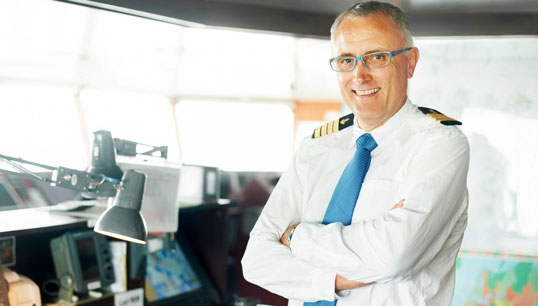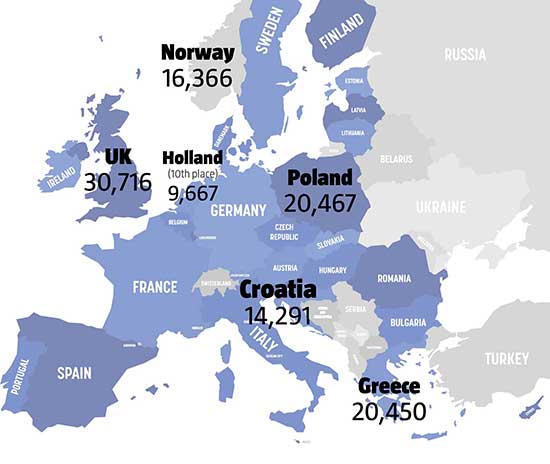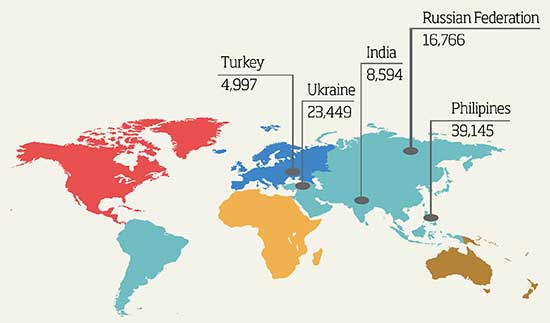- Topics
- Campaigning
- Careers
- Colleges
- Community
- Education and training
- Environment
- Equality
- Federation
- General secretary message
- Government
- Health and safety
- History
- Industrial
- International
- Law
- Members at work
- Nautilus news
- Nautilus partnerships
- Netherlands
- Open days
- Opinion
- Organising
- Podcasts from Nautilus
- Sponsored content
- Switzerland
- Technology
- Ukraine
- United Kingdom
- Welfare

Annual seafarer data from the European Maritime Safety Agency (EMSA) secured pre-pandemic shows continued relative stability in Europe. Andrew Linington reports
The annual seafarer statistics report compiled by the European Maritime Safety Agency (EMSA) concludes that the number of masters and officers available to serve on EU-flagged vessels remained broadly stable over the five years running up to 2018.
It found that the European maritime labour market has been able to attract new entrants that have replaced those leaving the seafaring career.
Masters and officers
The number of masters and officers certified by EU countries rose by more than 7,000 from the previous year. There has also been signs that the number of EU masters and officers was set to increase further, with the average age of those serving on European ships having stabilised in recent years.

The statistical review is based on data extracted from certificates and endorsements registered by EU member states up until 31 December 2018 and recorded in the STCW Information System. EMSA said it represents a snapshot of the European labour market in terms of the number of seafarers holding valid certificates and endorsements in 2018.
Data supplied by the 29 EU member states showed that at the end of 2018 almost one-third of a million masters and officers were available to serve on EU-flagged ships – of which around 30% were from countries outside the region and almost 56% were qualified to serve at management level on ships of 3,000gt and above.
Masters and officers from 155 countries are eligible to serve on EU-flagged ships. EU nationals account for almost 62% of the total, while just over one-fifth are from Asia, 15% from non-EU European countries, and around 1.5% from Africa and the Americas.
Endorsements of Recognition
A total of 106,334 masters and officers with certificates issued by 87 different countries held Endorsements attesting their Recognition (EaRs) by EU member states – like the UK's certificates of equivalent competency (CeC). Just over 80,000 of these were in the deck department and 75,378 were engineers.
One-third of the EaRs had been issued to endorse CoCs held by officers from other EU member states. Poland (9,897), Romania (6,203), Greece (5,002), Croatia (4,099) and the UK (4,065) were the EU countries with the most officers recognised by other countries. A total of 2,143 Dutch officers also held EaRs in 2018.
Nautilus has repeatedly lobbied the UK government for assurances over the future recognition arrangements for the certificates of British officers serving on other EU-flagged ships in the event of a no-deal Brexit.
According to the report, a total of 209,192 masters and officers held valid certificates of competency (CoCs) issued by EU member states (compared with 202,190 in the previous year) of which 126,546 were in the deck department and 87,363 were engineers. Just 3.45% have dual certification, entitling them to serve in either department.
The five EU member states with the highest number of certificated masters and officers during 2018 included the UK (30,716), Poland (20,467), Greece (20,450), Norway (16,366) and Croatia (14,291). The Netherlands was in 10th place, with a total of 9,667 masters and officers.
Around 8% of the CoCs issued by EU member states are held by non-EU nationals – and more than 80% of these are from Asian countries.

EMSA said its analysis showed the average age of masters and officers was 43.6 years, with almost two-thirds of those qualified as master or chief engineer aged 45 or older. Chief engineers had the highest average age of any rank – 49 years – compared with 48.6 years for masters and just 33.7 years for chief mates up to 3,000gt.
Just over 3.5% of EU masters and officers were aged under 25, the report states, and almost 12.5% of masters and deck officers and nearly 15% of engineer officers were 60 or older.
However, the report says the average age of masters and officers serving on EU-flagged ships has remained stable in recent years. The average age of those holding CoCs at management level is also not increasing, the report adds, and 'this may suggest that officers of a lower rank are progressing in the seafaring career'.
Only 2.22% of the EU-certificated masters and officers are women and of these, less than 20% serve as engineers. The average age of female masters and officers was 34.3 years, and three-quarters were younger than 40 years.
The EMSA report makes a gloomy forecast for the gender balance in EU shipping. 'The percentage of female officers globally continues to be expected to increase in the coming years. However, it is unlikely that globally they will reach the 2% of the total number of masters and officers already available to serve onboard EU member state flagged vessels.'
The five EU member states issuing the most EaRs for masters and officers in 2018 were Malta (64,158), Cyprus (27,038), Norway (13,645), the UK (12,511) and Portugal (11,552). The Netherlands was in sixth place, having issued a total of 10,761 EaRs.
The top five suppliers of non-EU masters and officers were the Philippines (39,145), Ukraine (23,449), the Russian Federation (16,766), India (8,594) and Turkey (4,997).
The bulk of EaRs issued by the UK went to masters and officers from the Philippines, China, the Russian Federation and Ukraine. The vast majority of EaRs issued by the Netherlands were to those from the Russian Federation, Ukraine, and the Philippines.
EMSA said the figures showed that the majority of officers from Asia holding EaRs issued by EU member states were qualified to serve at operational, rather than management, level and the average age of officers issued with EaRs was three years less than that of officers holding CoCs issued by EU member states.
A total of 16,730 officers from 113 different countries hold CoCs issued by EU member states, the report notes. Almost 90% of these were issued by the UK, where almost half the CoCs it issued have gone to non-EU nationals – 13,847 of these to seafarers from Asian countries.
Nautilus has repeatedly lobbied the UK government for assurances over the future recognition arrangements for the certificates of British officers serving on other EU-flagged ships in the event of a no-deal Brexit.
Overall, the top 10 EU countries supplying maritime labour to the EU have remained broadly the same for the last three years, EMSA said.
The report points out that the five non-EU countries supplying the most masters and officers to the EU-flagged fleet had retained their places in the 'league table' over the last five years, while the rankings for EU countries had been much more fluid over the same period.
The report says there are signs of a potential increase in the number of certificate holders from EU member states, although it predicts a slight decrease in the number of UK and Polish officers in the coming years, as well as an increase in Greek numbers.
Earlier forecasts of a decline in the number of Filipino masters and officers have not materialised, it adds, although a reduction is still expected in the following two years.
Question marks over EU recognition of certificates issued in the Philippines have been regularly raised in recent years after EMSA audits found evidence of shortcomings in standards within the national maritime administration and at training institutions. A further EMSA audit of Philippines compliance with the STCW Convention was due to take place in March this year.
EU Ratings data
Only 16 EU member states supplied data on the number of ratings holding valid Certificates of Proficiency (CoPs) – and Poland topped the table, with a total of 12,549, followed by Spain (12,132), and Italy (6,574). Neither the UK nor the Netherlands were included in the list.
The ratings covered by the survey came from 103 countries and almost two-thirds were serving in the deck department, with 6.57% qualified to serve in both the deck and engineering departments. The average age of ratings holding valid CoPs was 40.8 years and around 3.73% of the ratings were female, EMSA added.
This is the fifth time that EMSA has produced its seafarer statistics report and it says the inclusion of data from Norway and Iceland has increased the reliability of its figures. It remains to be seen, however, what impact the coronavirus crisis will have on its predictions of continued relative stability in the EU maritime labour market.
Tags
